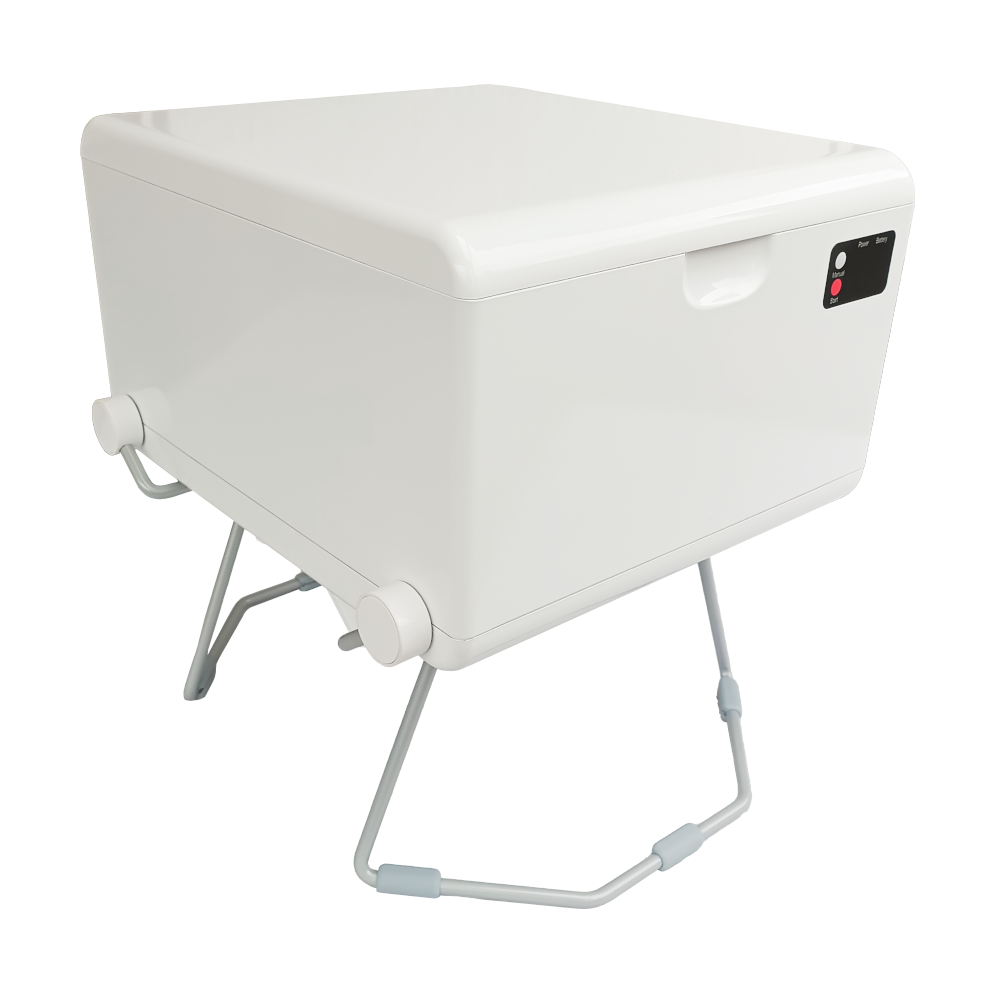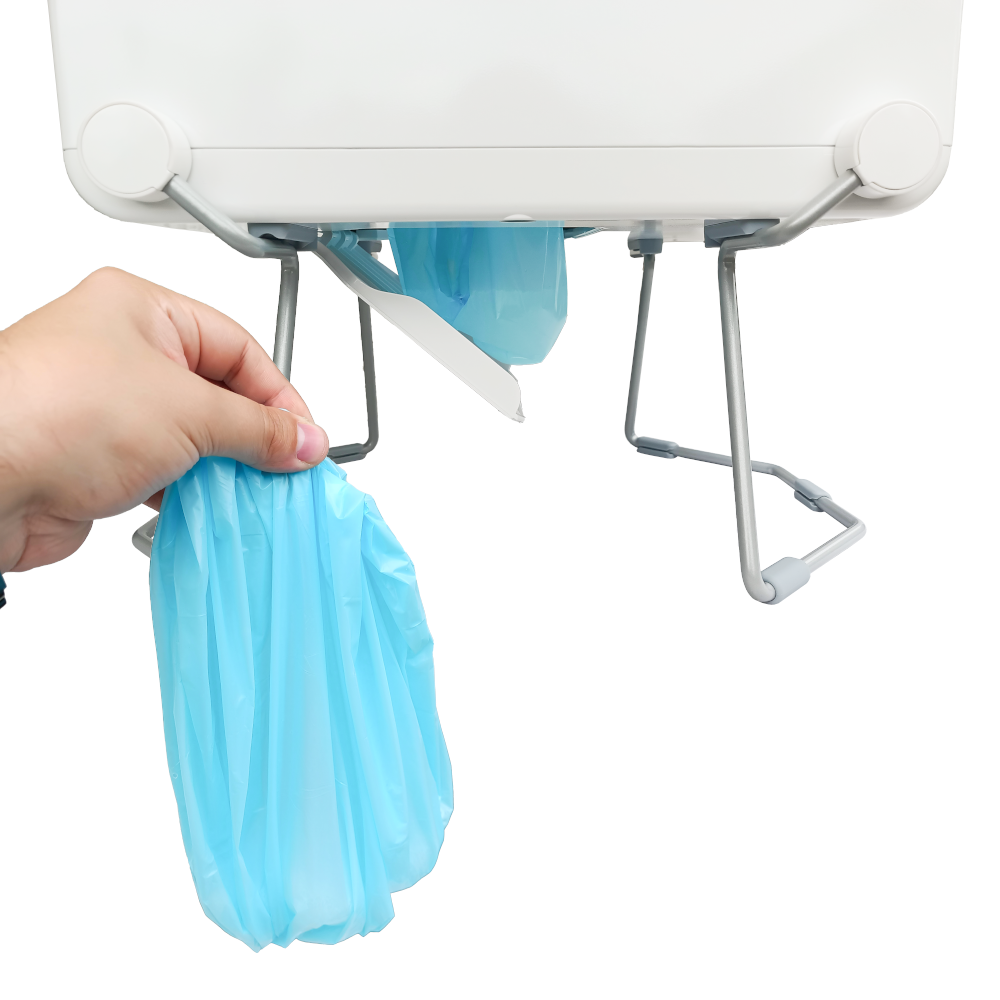A sealing toilet, as the name suggests, works on the principle of welding. With this variant, the camping toilet can weld individual bags. In other words, bag welding takes place. The liquids, such as urine and solids, go into one and the same bag, are then sealed airtight and germ-free and disposed of. Unlike a composting toilet, there is no separation or drying of urine and solids.
How does a sealing toilet work?
With a sealing toilet, a barrier film, a so-called liner, is inserted or pulled onto a ring under the toilet seat. Depending on the model, this has a different capacity for toilet trips until the liner of the camping toilet is used up and has to be replaced again. With our LooSeal EVO, for example, you have 30 toilet trips per liner at your disposal. At the end, the bag is automatically sealed airtight, germ-free and odourless at the push of a button. During this process, a latch in the camping toilet, to which the Teflon tape is attached, moves forward and seals the bag with the help of an opposite Teflon tape. At the same time, the bag is also separated from the rest of the liner. This can then either be removed immediately at the bottom or collected in an extra container. The bags are then disposed of in the residual waste.

How do I prepare a sealing toilet?
In order for the camping toilet to be put into operation, it must be connected to the mains or, in the case of a portable sealing toilet such as our LooSeal EVO, the battery must be fully charged. This is important so that the camping toilet can seal the bags. Here we distinguish between a fixed sealing toilet and a portable one. The portable sealing toilet with rechargeable battery is ideal for campervans, smaller vehicles or even for the car. The fixed camping toilet can replace a previous chemical toilet and is intended for permanent use. In addition, if the existing liner no longer has capacity, a fresh barrier liner must be inserted. The liner is then hermetically sealed for the first time by a welding process and is thus ready for use.
How do I use a sealing toilet?
To use the sealing toilet, apart from a full battery or a fixed power source and a liner, there is no need for much preparation. It can seal almost anything. Bag sealing can then be started at any time. When choosing a liner, for the sake of the environment, make sure they are biodegradable and compostable. Before the actual use and thus also the bag sealing, it is recommended to tip a packet of super absorber, which should also be bio-based, into the toilet opening. This is there to soak up liquids and make them gel-like, thus providing additional safety when transporting the full bag. In addition, the granulate serves as an odour inhibitor and makes unpleasant smells disappear. The rest of the procedure is similar to the toilet at home, with the difference that no water is needed. After using the toilet, the start button is pressed for a few seconds to start the sealing process automatically. Now the camping toilet will seal the bag. The bag with contents is automatically pulled down, sealed airtight, germ- and odour-free. The foil liner for the next toilet use renews itself completely independently by pulling the liner downwards. The sealing toilet is now ready for the next use.
How do I dispose of the bag?
The airtight, germ-free and odourless bag is discharged from the bottom of the sealing toilet after bag sealing. If there is no extra collection container, the bag can be removed from the bottom without further loosening, as the sealing process automatically detaches it from the liner. If the sealing toilet has a container, the bags end up in it and can then be disposed of collectively. After the bag-welding process, the used bags can simply be disposed of in the residual waste, so there is no need for a disposal station, as is the case with chemical toilets, for example. When it comes to compostable bags and decomposable granules, they should not be stored for longer than a maximum of one week. This ensures that it is still in tact when it is finally disposed of and that no excreta or odour escapes.

What are my costs with a sealing toilet?
Unlike a composting toilet, where the costs during use are very low, the sealing toilet is more costly to use. In terms of power consumption, however, the sealing toilet hardly differs from a composting toilet, as it is also connected to the mains or powered by a low-impact battery. The difference is that the camping toilet can seal bags and needs electricity to do so. However, when converting for a permanently installed sealing toilet without a rechargeable battery, the cable cross-section should definitely be taken into account. Since bag welding takes place, a liner that reliably collects the excreta and can be welded airtight is absolutely necessary for using the camping toilet. It is also recommended to use the super absorber before use, especially for the small business, in order to be able to weld everything compactly. Since the sealing toilet is not functional and cannot seal without these two additives, it is advisable to always keep them in stock. Otherwise, bag sealing is not possible. The running costs here are higher than for example for coconut fibre, peat or small animal litter, which is used for dry separation toilets or composting toilets. These camping toilets do not weld and there is no bag welding but separation and drying.
What advantages does a sealing toilet offer?
One of the biggest advantages of the sealing toilet is that there is hardly any other system that works so hygienically and germ-free. Due to the fast welding, you do not come into contact with excretions and can dispose of them immediately. In addition, feminine hygiene articles, nappies or even leftover food can be disposed of in a sealing toilet. This has no influence on the sealing process. With a portable sealing toilet like our LooSeal EVO, you have the additional advantage that it can be set up anywhere and at any time without much effort. If it is no longer needed, it can be folded up and stored in a space-saving way. Another advantage is that it is child's play to operate and the sealing toilet can function and seal the bags under all circumstances, i.e. even in the case of illness or tropical climates.
What are the disadvantages of a sealing toilet?
One disadvantage of the sealing toilet is the slightly higher running costs, as material is needed to use the camping toilet correctly. In addition, one is dependent on the availability of liner and absorber, without which the toilet is not functional. Therefore, a sealing toilet is less self-sufficient than composting toilets or composting toilets, as the barrier liner and super absorbers must necessarily be purchased from the toilet manufacturer. Liners from other manufacturers usually do not fit into the toilet system or even cause damage to the sealing toilet.